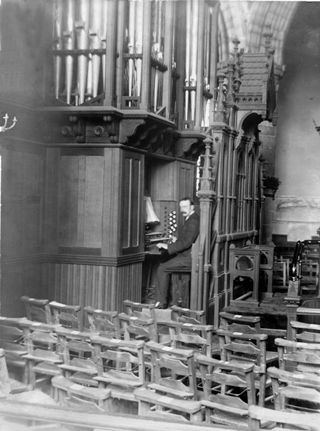Aberdeen Bach Choir - its Roots in History
The first performance of a J.S. Bach work in Aberdeen is believed to have taken place on Tuesday 2 April 1912 in St Machar's Cathedral, when a performance of the St Matthew Passion was advertised in that day's Aberdeen Journal under 'Amusements':
Bach’s “Passion Music”
Will be Sung in S MACHAR’S CATHEDRAL
THIS EVENING at 7.45 o’clock
Doors open at 7.15 p.m.
Silver Collection on Entering
Special Cars will be at School Road on
conclusion of Service
[The Aberdeen Daily Journal Issue 17856 Tuesday, April 2, 1912 page 1]
On the following day, the same newspaper printed a lengthy critique of the performance (sadly, its successor the Press and Journal no longer reports on Aberdeen Bach Choir performances). The special cars (trams) would have been needed because the event was in the form of a religious service. As the two part work itself lasts for the best part of three hours, and sermons in those days tended to be on the long side, it would have lasted well into the night, though the newspaper report reveals that the absence of the Rev. Dr. Martin Lewis led to the omission of the sermon. That left the Rev. Dr. Calder and the Rev. Joseph Shillinglaw to conduct the devotional exercises and the lesson. 'There was a very large audience, every seat being occupied.'

Dawson at the organ in St Machar's Cathedral in its original location in front of the East window
The choir was a double choir of 60 voices, with the addition of a 'contingent of boys from Paisley Abbey' who 'assisted the sopranos'. Henry Brearley and William Hayle, professional singers from Leeds, took the tenor and bass parts, but the ladies taking the soprano and alto parts were not named. The conductor was W.T. Clemens. R.T. McEwan of London accompanied a number of the recitatives and connecting passages on 'a tinkling piano' to the irritation of the author of the critique, who went on to comment 'The austere nature of the man is strongly reflected in the music, and there must be no distraction from its gravity and solemn dignity.' N.E.C. Dawson (organist at the Cathedral) was commended for his pedal accompaniment to the chorales on the Willis organ, while P. Boothroyd of Paisley Abbey played the small organ.
The success of this performance, and the driving force of Professor Charles Sanford Terry (1864-1936), was probably the impetus for the formation of the Aberdeen Bach Society in 1913. Terry was Burnet-Fletcher Professor of History and Archaeology at the University of Aberdeen from 1903 to 1930 and previously a lecturer in History there from 1898 until 1903. Terry had been a choirboy at St Paul's Cathedral Choir School, where Stainer was the organist. A keen amateur musician, he conducted the Aberdeen University Choral and Orchestral Society from 1898 and founded the Aberdeen and North East Scotland Music Festival in June 1909.
'Musical Times' of July 1913 reported on a second performance of the St Matthew Passion (though the article stated it was the first) during the 1913 Festival in May of that year. The choir (rehearsed and conducted by Warren Clemens who had conducted the 1912 performance) and orchestra, conducted by Hamilton Harty, numbered 330 in total. The venue was not given but it is unlikely to have been St Machar's Cathedral with such a large complement of singers and players. However in those days the capacity of the Cathedral was almost certainly much greater than it is today and it is not out of the question that the performance was in the Cathedral. Soloists were Miss Jane Burt, Miss Dilys Jones, Mr Gervase Evans and Mr Campbell McInnes. This performance was 'unquestionably an adequate one' and 'the Festival choir greatly distinguished themselves.'
The history of the Aberdeen Bach Society is the subject of further research.
Aberdeen Bach Choir
Scottish Registered Charity Number SC008609

